Use of the DAindexTM for monitoring fruit ripening evolution in A. chinensis to precisely assess harvesting time “in planta”
Abstract
BACKGROUND: The assessment of the fruit maturity stage is essential to establish the optimal harvest time and it is considered to be crucial to determine the overall quality and the length of fruit storage-life. In fact the maturity stage reached at harvest is strictly related to the fruit characteristics such as flesh color, taste and aroma resulting in high consumer acceptability. Fruits from the Actinidia chinensis cultivar are traditionally harvested when the flesh color reaches a value of 103° Hue equivalent to a bright yellow color (“gold”), recognized as optimal to fulfill the supply chain requirements. This parameter is measured on a fruit sample in the last phase of maturity with a colorimeter, after removing of a thin layer of epicarp. However, since this method implicates the fruit sample destruction, the batch of the considered fruits could be poorly representative.
OBJECTIVES: A non-destructive alternative for the assessment of fruit ripening/harvesting was investigated.
METHODS: The recently developed Kiwi-meter, a device based on the vis/Near Infrared Spectroscopy (NIRs) allows to monitor fruit flesh color evolution non-destructively by means of the DAindexTM.
RESULTS: This work reports the results obtained in different trials in the past years on two A. chinensis cultivars and confirms the importance of the Kiwi-meter device to establish the proper fruit harvest time, fundamental to optimize quality and post-harvest management of kiwifruit, by grouping fruits in homogeneous ripening classes.
CONCLUSIONS: The results showed that the Kiwi-Meter could be used “in planta” to monitor the ripening evolution and to assess the harvest time.
1Introduction
The ripening stage of the kiwifruit at harvest must be determined with great accuracy since it influences the quality at consumption and the post-harvest fruit management. In fact, when fruit harvest is performed too early, before the fruits reached the physiological maturity “in planta”, fruit quality is poor, characteristic aroma and flavor are not built and fruit do not fulfill consumer expectations [1].
However, although fruit quality is recognized as a very important aspect [2, 3], Actinidia chinensis fruits have to be harvested when the flesh color reached a °Hue value of 105-103, that represents the color change from green to yellow [4]. It has also to be considered that this value has been specifically determined for Hort16A, the first Actinidia chinensis cultivar diffusely introduced on the market [5]. However this value is also used for other A. chinensis cultivar while specific studies should be carried out to exactly determine the appropriate °Hue value for each of the variety actually cultivated. In addition, this parameter is measured by a colorimeter on a fruit sample in the last phase of maturity, after a thin layer of epicarp is removed. This implicates the fruit sample destruction and, as a result, a poor representativeness of the batch of the considered fruit.
To overcome this inconvenient and to assess the fruit ripening/harvesting time, the University of Bologna realized and patented a non-destructive simplified vis/NIR device (Kiwi-Meter). This instrument permits to characterize the fruit ripening evolution at field level on a given sample of fruit and it allows repeating the measure on the same fruit, avoiding its destruction [6].
2Material & methods
The trials were carried out in different seasons on two A. chinensis cultivar: “Jintao” and “Dorì”(Fig. 1A and B). Jintao is a cultivar bred in China, which plant variety rights belong to the Wuhan Institute of Botany, China. The variety has been purchased by the Consorzio Kiwigold of Pievesistina (FC, Italy), which is responsible for the multiplication and diffusion [7]. The Jintao fruit is long, cylindrical and uniform with an average weight of 85 g. The flesh color is green-yellow at harvest and tends to become yellow during post-harvest [7]. “Dorì” is the last release among the A. chinensis cultivar obtained by a joint breeding research program by the Italian Universities of Bologna and Udine, which own the patent right. The fruit is long, cylindrical and characterized by a very homogenous shape; the average fruit weight reaches 104 g. The flesh colour is bright yellow and is formed very early in the season (beginning of September) [8]. The variety has been purchased by the Summerfruit s.r.l., located in Castel Bolognese (RA, Italy), which has the responsibility of the variety multiplication and diffusion [8, 9].
The research has been carried out on “Jintao” since 2009, while on “Dorì” the research has been carried out for 10 years [8–10]. In this study, for a better comprehension, only data relative to 2013 for “Jintao” and to 2013 and 2014 for “Dorì” are reported and discussed.
The fruit ripening evolution of the fruit attached to the vine was determined by the Kiwi-Meter while the assessment of the main fruit quality traits (soluble solids content, flesh firmness, flesh color) by using standard methods. As far as the non-destructive method, the former Department of Fruit Tree and Woody Plant Sciences of the University of Bologna developed the DA-Meter, a portable, user-friendly vis/NIR device, capable to measure the Index of Absorbance Difference (IAD) and the Kiwi-Meter (Fig. 2), specifically realized for the kiwifruit. The Kiwi-Meter differs from the DA-Meter for the selected wavelengths 560, 640 and 750 nm. The difference between A(560) and A(750) is used for the Actinidia deliciosa fruits and the difference between A(640) and A(750) for the Actinidia chinensis fruits. Both DA- and Kiwi-Meter and the DAindexTM (IAD) were patented by the University of Bologna [6, 11–14].
The fruit ripening evolution was determined on a selected number of fruits (100) still attached to the vine, starting from 90 days before the expected harvest up to the harvest time. The harvest was performed when the flesh color reached 103° Hue value, typical of the change from green to yellow.
As far as the main quality traits assessed with the standard methods, the soluble solids content (SSC, expressed as °Brix) was evaluated with a refractometer (Atago, Tokyo, Japan), the flesh firmness (FF, expressed as Kg/cm2) with a penetrometer (FTA Guss, South Africa) and the flesh color with a colorimeter (Minolta) using the standard protocols normally adopted [15].
Standard and non-destructive analyses were performed on a 100 fruit sample and data collected were statistically evaluated using the software STATISTICA 7 (StatSoft. Inc., Tulsa, USA) and the Duncan’s multiple range t-test at p < 0.05.
3Results
In “Jintao”, the DAindexTM data collected in 2013 showed values decreasing from 1.5 to 0.9. The harvest was performed when a DAindexTM reached a value below 1.25 corresponding to a Hue value of 103° (Fig. 3) [13]. A strong correlation between IAD and Hue values was found in all the years (R2 = 0.819 during 2013, Fig. 4) [16, 17].
The data collected on the “Dorì” fruit ripening evolution in 2013 and 2014 showed a similar trend (Fig. 5); on this variety the harvest was performed when the DAindexTM value ranged around 1.15-1.10 corresponding to °Hue values of 103-102. Also in “Dorì” the correlation between DAindexTM and Hue value was very high (R2 = 0.750, Fig. 6) [9].
The DAindexTM changes did occur in the last 30–40 days before the harvest, while before the Kiwi Meter pointed out no changes. In the last period the ripening curve is linear and the DAindexTM data correlate with the Hue data allowing to estimate with a high degree of precision the moment to perform the harvest (Fig. 7).
The Kiwi-Meter also allows grouping the fruits in homogeneous classes according to their ripening stage and the consistence of the fruits forming each class. In “Jintao”, it is interesting to point out the differences in the ripening distribution of the fruits in two different moments. In 20 days time the fruits shifted toward classes characterized by an advanced ripening stage (expressed by low DAindexTM) (Fig. 8) [17].
In “Dorì”, it has to be underlined that the ripening trend monitored from the 1st of September (DAindexTM 1.15 and Hue angle of 103°) up to the 19th of September (DAindexTM 0.92 and Hue angle of 98°) showed that fruit can be harvested for quite a long period (around 20 days) without undergo high softening rate (FF from 6.5 to 5.5 kg/cm2), while SSC increased in the same span of time (Table 1). In addition in “Dorì” no differences among fruits were detected as far as ripening and fruit abscission are concerned during all the years of evaluation (data not shown).
4Conclusions
The results showed that the Kiwi-Meter can be used “in planta” to monitor the ripening evolution and assess the harvest time, without destroy the sample of the analyzed fruits. After harvest, the Kiwi-Meter allows to select fruit in classes of uniform ripening.
The DAindexTM value to perform the harvest are slightly different among the two variety: “Jintao” fruit must be harvested when the DAindexTM value are below 1.25 corresponding to a Hue angle value of 104-103 while the optimal DAindexTM value for “Dorì” fruit ranged between 1.2 e 1.0.
As far as the fruit ripening distribution, the DAindexTM value monitored in the last phase of the ripening curve, 35–40 days before the expected harvest, defined the distribution and the percentage of fruits according to their different ripening class. Indication on the ripening homogeneity and on the consistency of the most representative classes is useful to establish the best storage and marketing strategy.
References
[1] | Costa G , Noferini M , Montefiori M , Brigati S . Non-destructive assessment methods of kiwifruit quality. Acta Horticulturae. (2003) ;610: :179–190. |
[2] | Harman JE . Kiwifruit maturity. Orchardist NZ. (1981) ;54: (4):126–127, 130. |
[3] | Shewfelt RL . What is quality? Postharvest Biology & Technology. (1998) ;15: :197–200. |
[4] | Minchin PEH , De Silva N , Snelgar WP , Richardson AC , Thorp TG . Modelling of colour development in the fruit of Actinidia chinensis ‘Hort16A’. NZ J Crop Hort Sci. (2003) ;31: :41–53. |
[5] | Costa G , Bonora E , Fiori G , Noferini M . Innovative non-destructive device for fruit quality assessment. Acta Horticulturae. (2011) ;913: :575–581. |
[6] | University of Bologna patent n° PDA000081, 2009. |
[7] | Huang H , Wng S , Huang R , Jiang Z , Zhang Z . “Jintao” a novel, hairless, yellow fleshed kiwi-fruit. Hort Sci. (2002) ;37: :1135–1136. |
[8] | Costa G , Fiori G , Donati I , Spinelli F , Piccinini L , Cipriani G , Testolin R . Dorì, nuova varietà di A. cinensis. Rivista di Frutticoltura. (2014) ;1/2: :16–20. |
[9] | Fiori G , Costa G . Monitoraggio della maturazione in pianta della cultivar Dorì e definizione del momento ottimale di raccolta con l’utilizzo del Kiwi-meter. X Convegno Nazionale Actinidicoltura, Latina 3-4 Dicembre. (2014) (in press). |
[10] | Nardozza S , Fabbroni C , Raimondi V , Testolin R , Costa G . Primi risultati relativi ad un programma di miglioramento genetico per l’identificazione di nuove selezioni di Actinidia chinensis. 8° Convegno Nazionale Actinidia. Atti del Convegno. (2007) )114–121. |
[11] | University of Bologna patent n° MO 2005000211, 2005. |
[12] | Costa G , Bonora E , Noferini M . Modeling system and vis-NIR devices to improve pre- and post-harvest management. ISHS Peach Symposium, Matera Acta Horticulturae. (2013) . (in press). |
[13] | Costa G , Vidoni S, Rocchi L, Cellini A, Buriani G, Donati I, Spinelli F. Innovative Non-destructive Device for Fruit Quality Assessment and Early Disease Diagnosis. 8th ISHS Kiwifruit Symposium, Chengdu, China. Acta Horticulturae. (2014) . (in press). |
[14] | Pellegrino S , Costamagna F , Noferini M , Costa G . Monitoring of ‘Hayward’ (Actinidia deliciosa) Fruit Ripening in North-West Italy. Acta Horticulturae. (2011) ;913: :665–669. |
[15] | Montefiori M , Noferini M , Biondi C , Costa G . Valutazione del metodo di raccolta “Kiwi-start” nelle nostre situazioni colturali. Italus Hortus. (2003) ;6: :329–334. |
[16] | Noferini M , Piccinini L , Bonora E , Fiori G , Costa G . Il DA-meter, una strumentazione non distruttiva per determinare il momento di raccolta e lo stadio di maturazione dei frutti di Actinidia deliciosa ed Actinidia chinensis. Italus Hortus. (2009) ;16: (5):297–300. |
[17] | Noferini M , Soto A , Fiori G , Piccinini L , Mauri S , Costa G . Actinidia a polpa gialla: Misurare alla raccolta la variabilità della maturazione. Rivista di Frutticoltura. (2013) ;9: :2–6. |
Figures and Tables
Fig.1
Jintao fruit (A); Dorì fruit (B).

Fig.2
The Kiwi-Meter, a portable, non-destructive vis/NIR device used to measure the DAindexTM and to follow the fruit ripening of the fruits when attached to the vine.
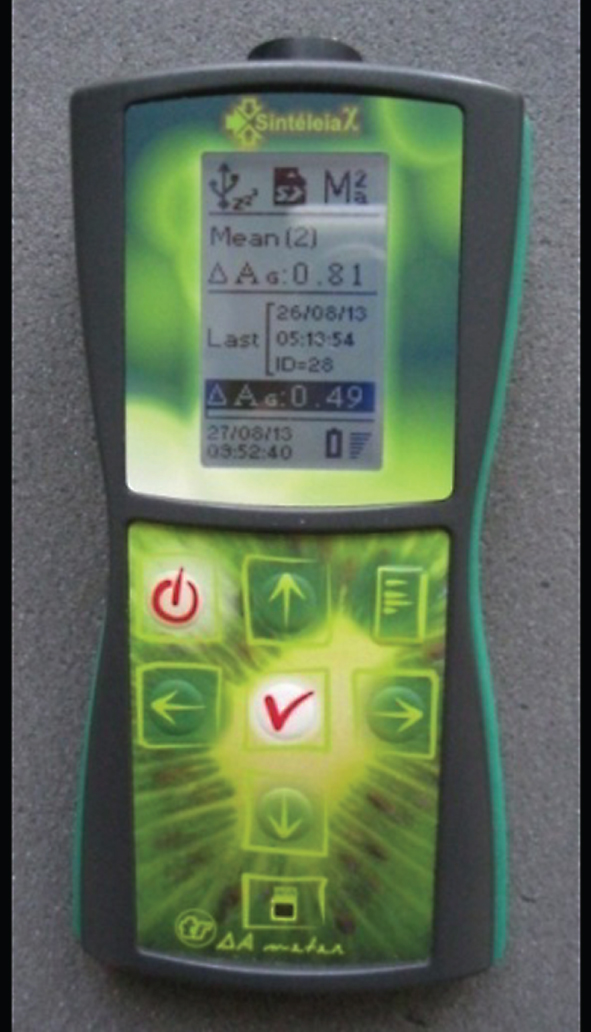
Fig.3
Ripening trend in Jintao fruits expressed as Hue angle and DAindexTM over days after full bloom (DAFB).
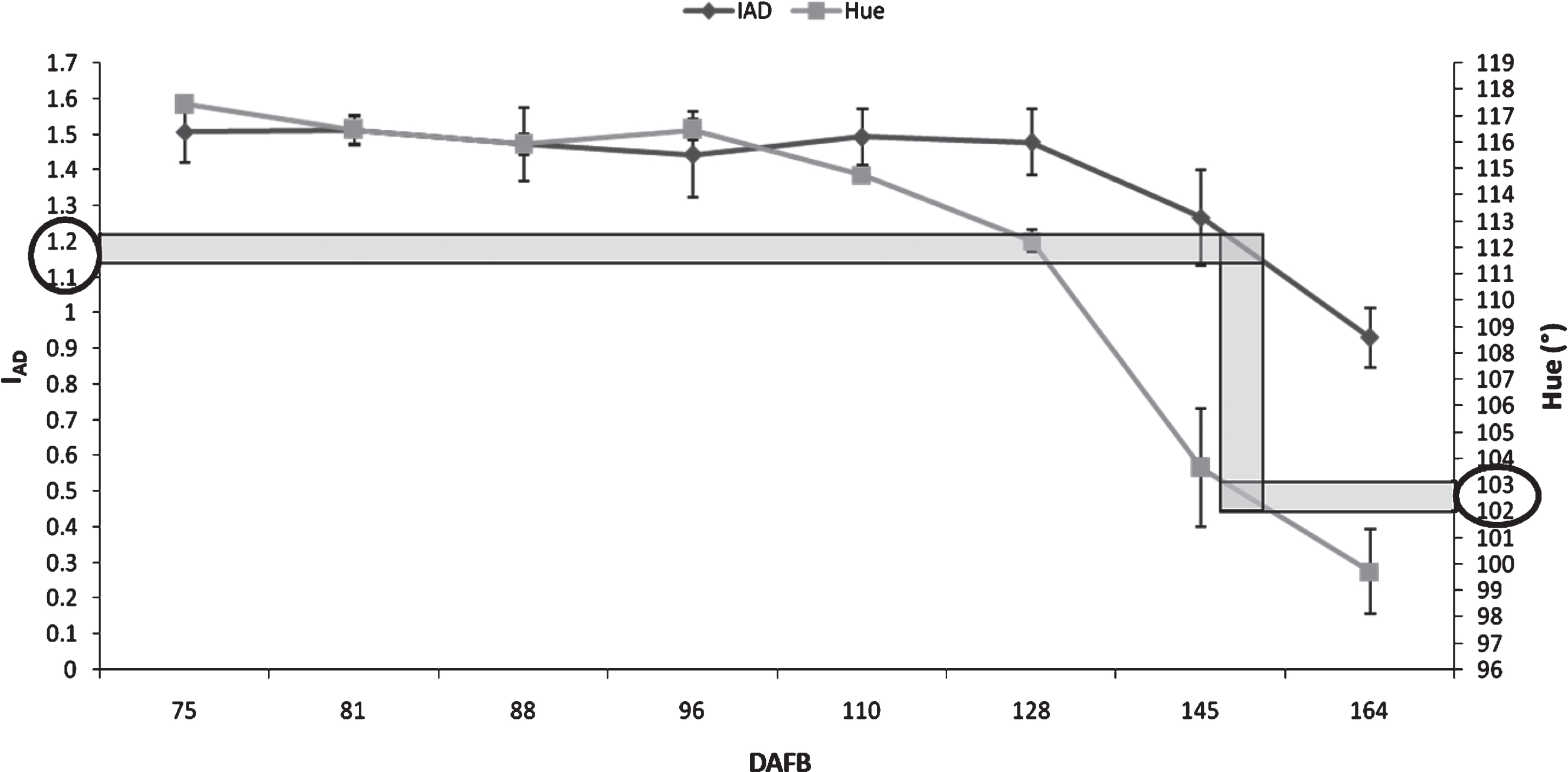
Fig.4
Correlation between flesh color (°Hue) and DAindexTM in “Jintao” fruit (A. chinensis).

Fig.5
Ripening trend (DAindexTM) in Dorì fruits in 2013 and 2014. *DAFB = days after full bloom.
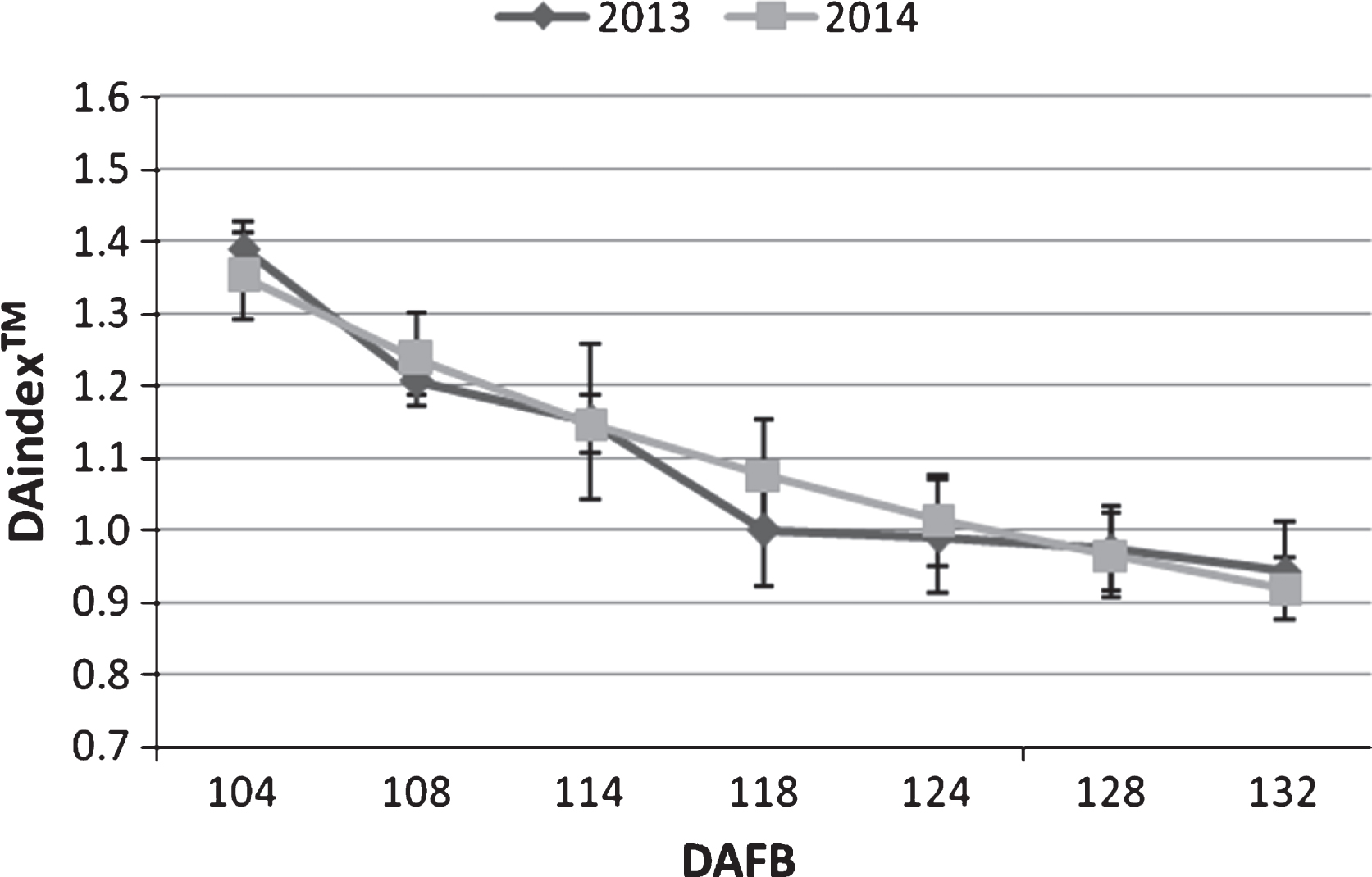
Fig.6
Correlation between the Hue angle and DAindexTM in “Dorì” fruit during 2014.

Fig.7
Evolution of the color of “Jintao” fruit flesh assessed by Hue angle and DAindexTM value in the last 40 days before harvest.
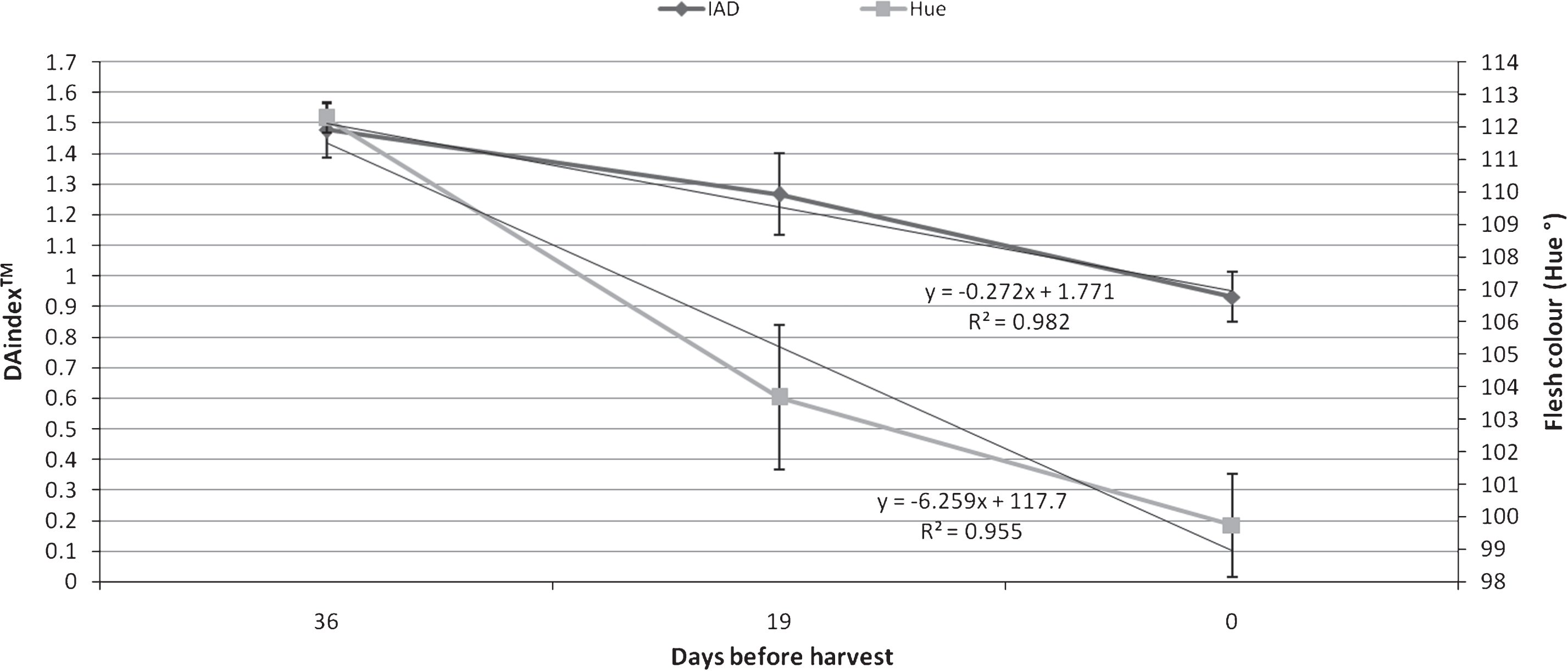
Fig.8
Fruits grouped in classes of homogeneous ripening in Jintao. Fruits were harvested in two different moments.
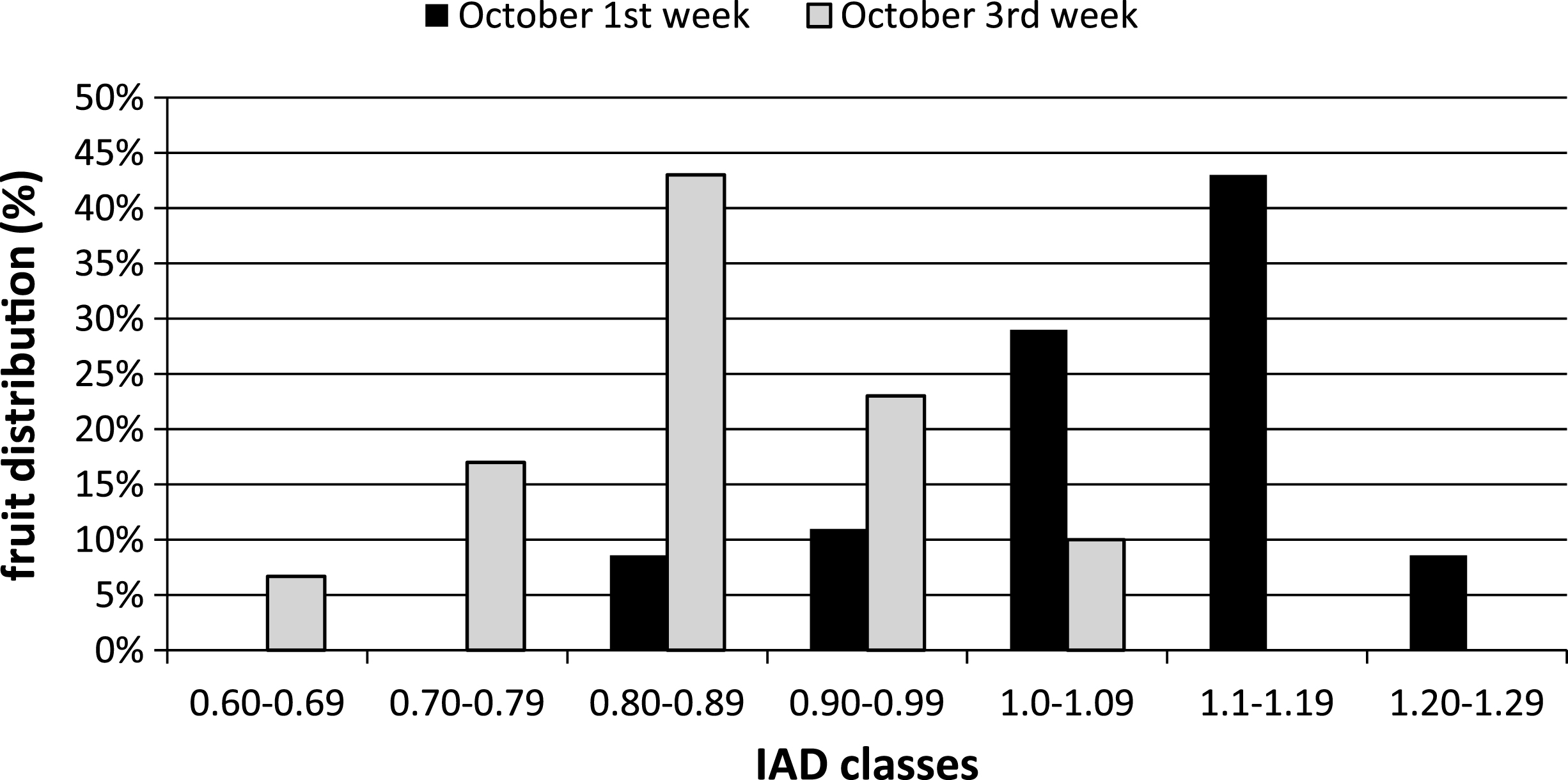
Table 1
DAindexTM and standard quality traits determined in a month span of time (22 August up to 19 of September) on the “Dorì” fruits
| Date | DAindexTM | Flesh color (°Hue) | FF (kg/cm2) | SSC (°Brix) |
| 22/08/2014 | 1.35±0.04 | 113±0.57 | 6.5±0.31 | 6±0.35 |
| 26/08/2014 | 1.24±0.02 | 107±0.79 | 6.5±0.35 | 6.4±0.18 |
| 01/09/2014 | 1.15±0.07 | 103±0.68 | 6.4±0.33 | 7±0.38 |
| 11/09/2014 | 1.01±0.13 | 102±0.57 | 6.5±0.26 | 7.2±0.30 |
| 15/09/2014 | 0.97±0.07 | 101±1.34 | 6±0.44 | 7.4±0.52 |
| 19/09/2014 | 0.92±0.09 | 98±0.89 | 5.5±0.55 | 8±0.47 |
Mean of 100 fruits±standard deviation. Underlined the optimal time of harvest.




